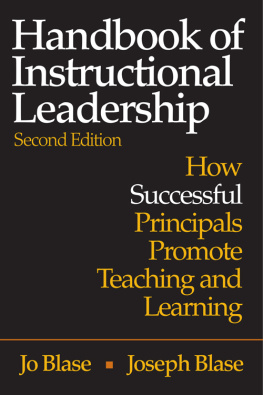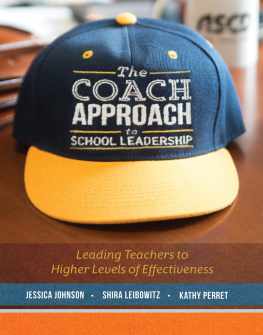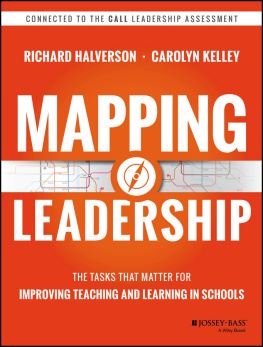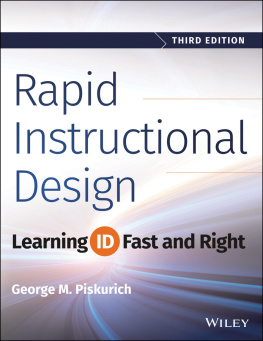
The Corwin Press logoa raven striding across an open bookrepresents the union of courage and learning. Corwin Press is committed to improving education for all learners by publishing books and other professional development resources for those serving the field of K12 education. By providing practical, hands-on materials, Corwin Press continues to carry out the promise of its motto: Helping Educators Do Their Work Better.

Copyright 2004 by Corwin Press.
All rights reserved. When forms and sample documents are included, their use is authorized only by educators, local school sites, and/or noncommercial entities who have purchased the book. Except for that usage, no part of this book may be reproduced or utilized in any form or by any means, electronic or mechanical, including photocopying, recording, or by any information storage and retrieval system, without permission in writing from the publisher.

For information:

Corwin Press
A Sage Publications Company
2455 Teller Road
Thousand Oaks, California 91320
www.corwinpress.com
Sage Publications Ltd.
6 Bonhill Street
London EC2A 4PU
United Kingdom
Sage Publications India Pvt. Ltd.
B-42, Panchsheel Enclave
Post Box 4109
New Delhi 110 017 India
Printed in the United States of America
Library of Congress Cataloging-in-Publication Data
Blase, Jo.
Handbook of instructional leadership: How successful principals promote teaching and learning / Jo Blase, Joseph Blase.2nd ed.
p. cm.
Includes bibliographical references and index.
ISBN 0-7619-3114-7 (Cloth)
ISBN 0-7619-3115-5 (Paper)
1. School supervisionUnited StatesHandbooks, manuals, etc.
2. Educational leadershipUnited StatesHandbooks, manuals, etc.
I. Blase, Joseph. II. Title
LB2806.4.B63 2004
371.203dc22 2003017813
This book is printed on acid-free paper.
03 04 05 06 07 10 9 8 7 6 5 4 3 2 1

| Acquisitions Editor: | Robert D. Clouse |
| Editorial Assistant: | Jingle Vea |
| Production Editor: | Denise Santoyo |
| Copy Editor: | Jackie Tasch |
| Typesetter: | C&M Digitals (P) Ltd. |
| Indexer: | Pam Van Huss |
| Cover Designer: | Michael Dubowe |
| Graphic Designer: | Lisa Miller |
D uring a break at a conference for educational leaders I attended a few years ago, I was chatting with a colleague who taught a course on instructional leadership. One of her former graduate students, now a school principal, stopped to say hello. Within a few moments the conversation turned to the coursework the former student had taken during his graduate program: I really enjoyed your course on instructional leadership, he said to my colleague, a professor with a reputation as an outstanding teacher. I dont get much of a chance to use instructional leadership in the real world, he continued with a smile, because Im too busy with all of the day-to-day responsibilities of being a principal. My colleagues only response was nonverbal, somewhere between a smile and a grimace. As I listened to this conversation, I reflected on the fact that many school administrators had expressed the same notion to me; for these principals, instructional leadership, like solar energy, is an interesting concept but a low priority. They wish that they had more time to devote to it. But the real world of the principalship that they describea world of discipline referrals, parental complaints, and bureaucratic paperworkleaves little room, they believe, for any instructional leadership beyond the traditional teacher evaluation process that they carry out once or twice a year. I have heard so many administrators state this belief that I refer to it as part of the conventional wisdom of traditional school principals.
In this second edition of the Handbook of Instructional Leadership, Blase and Blase prove that conventional wisdom concerning the principal and instructional leadership is utterly wrong. Put positively, the research reported on the following pages proves convincingly that successful principals are, first and foremost, successful instructional leaders. Based on the comprehensive description of how instructional supervision is actually practiced and how it affects teachers, the Blases provide strong support for the general premise that facilitative, supportive actions by principals as instructional leaders have powerful effects on classroom instruction, as well as the specific premise that spoken language has a powerful impact on teachers instructional behavior.
The Blases research shows successful instructional supervision to have such positive impacts on teaching and learning (and ineffective or nonexistent instructional supervision to have such negative impacts) that no one who reads this book will be able to justify the relegation of instructional leadership to the margins of educational administration. I have always believed that one reason many principals attend poorly or not at all to their instructional leadership responsibilities is that they lack information concerning exactly how one provides effective instructional supervision. The Blases detailed descriptions of the behaviors of good instructional leaders, contrasted with equally detailed descriptions of ineffective behaviors, provide the data-based knowledge that principals need to develop or enhance their own instructional supervision.
Whether describing the successful principals role in instructional conferences, staff development, and teacher reflection or the principals use of visibility, praise, and autonomy, the authors provide data-based descriptions of the goals that principals have when they use particular instructional leadership strategies, specific examples of those strategies, and specific impacts the strategies have on teachers. For each area of instructional leadership addressed in the book, summaries of research results serve as the skeleton, and extensive quotes from teachers who participated in the study flesh out the research findings. This second edition updates the knowldege based on successful instructional leadership (five instructional conference strategies, six ways principals support the study of teaching, six principal behaviors that foster teacher reflection, and so on), and adds a comprehensive new chapter on developing professional learning communities. The Blases rich descriptions of principals motives, behaviors, and impacts, combined with revealing quotes from teachers, bring to life for the reader such concepts as inquiry, reflection, collaboration, empowerment, and professional learning community. They enable the reader to encounter the spirit of schools where these ideas have become a reality. In the same vein, the authors findings, including the results of a new study on abusive principals, provide a distressing view of the negative impact on teachers from principals failure to effectively facilitate instructional conferences, staff development, and teacher reflection; in such cases, interruption, abandonment, criticism, and authoritarian control abound. Indeed, the contrast of successful and ineffective behaviors is so stark, so compelling that the reader is left with a sense of urgency, with a conviction that the findings reported here need to be disseminated as soon as possible to inservice and preservice principals, central office administrators, policymakers, and professors of educational administration!


















